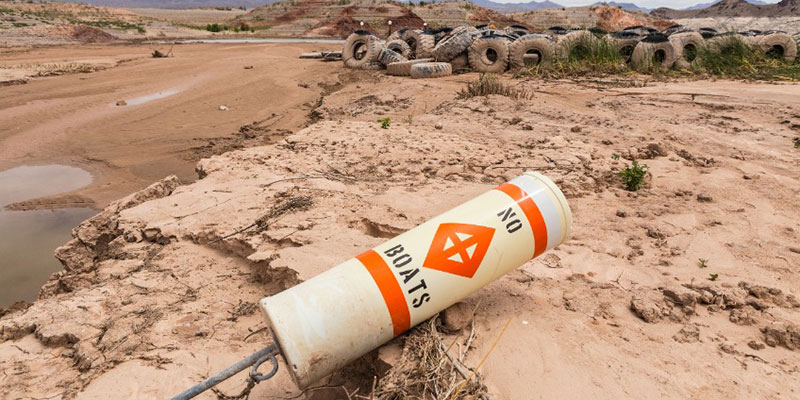A useless warning buoy lies on the dirt in Lake Mead near a pile of dumped tires, revealed as the lake’s water level continues to drop.
Strange scenes emerge from shrinking lake bed
A boat with its bow pointed skyward juts out of a dry lake bed, its stern lodged firmly in what once was mud. It’s hard not to see the image as a monument to the West’s 23-year megadrought, because this isn’t just any lake. It’s Lake Mead, the largest reservoir by volume in the nation. Millions depend on it for their very existence. It’s disappearing at an alarming rate: That boat was once 50 feet underwater.
At least 40 million people across 350,000 homes depend on Lake Mead’s waters for irrigation, drinking water, and hydropower. However, water levels have plummeted to their lowest mark since the 1930s, when Hoover Dam was built to flood the canyon and create the lake. Now, “bathtub rings” marking the 1983 high-water mark can be seen more than 170 feet up the canyon walls.
Items Exposed by Receding Waters
Many other curiosities have emerged from the water, including more stranded boats. A World War II-era Higgins boat lies on its side in the mud. Victims of suspected mob hits have been found in barrels. Old Coors cans, guns, strollers, tackle boxes, Prada sunglasses, exploded munitions, fake human skeletons, scattered real human bones, Native American arrowheads, and plenty of trash have appeared.
Online communities have sprung up to document the retreat, and treasure hunters have descended, hoping to find jewelry or even mythical mobster riches.
Drastic Water Cuts Proposed
Lake Mead is draining more quickly now that the lake is smaller; 20 vertical feet have been lost this year, which translates into 400 feet of shoreline recession.
Calls have come for cutting 2 million to 4 million acre-feet of water distribution in 2023. An acre-foot equals 325,851 gallons, or more than 1,233 m3. California, Arizona, and Nevada used about 7 million acre-feet from the Colorado River last year, and cuts would affect agriculture in California and Arizona, which supply approximately a quarter of the nation’s fruits and vegetables.
Rethinking Water Sources
To save Western communities, alternative water sources are becoming more and more important as aquifers are depleted and reservoirs recede.
Some have proposed small-scale desalination of brackish groundwater. Brackish aquifers are much more plentiful than freshwater ones and the water is more easily desalinated than seawater. Small units like Fluence’s NIROBOX™ are ready to deploy for brackish desalination.
Another solution is water reuse. It doesn’t make sense to use water just once, and treating wastewater for nonpotable applications like agricultural irrigation is less expensive than desalination.
Although some large-scale reuse projects are underway, like Operation Next in Los Angeles, modular equipment suitable for smaller, decentralized projects has made water reuse viable on any scale. Fluence’s Aspiral™ units, with energy-saving membrane aerated biofilm reactor (MABR) technology, have been cleared to operate in compliance with California Title 22 reuse regulations.
Contact Fluence to explore opportunities to develop new water supplies with NIROBOX™ and Aspiral™ modular plants. Water Management Services has financing structures, including BOO and BOOT contracts, can eliminate upfront investment and operations and maintenance concerns.

